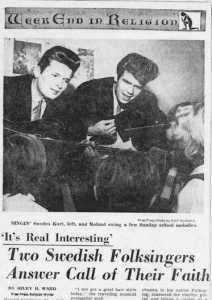It’s not often that Swedish Pentecostal singers end up on the front pages of American newspapers. But in December 1965, the country duo Curt & Roland in the Detroit Free Press under the heading “Two Swedish Folk Singers Answer Call of Their Faith.” The young musicians Curt Petersen and Roland Lundgren were visiting Reverend Ralph Hart’s Liberty Temple Church, an independent Pentecostal congregation in Detroit, proudly preaching a message of happiness and joy in Christ.

Curt & Roland powerfully illustrate the Transatlantic connections between believers in the postwar years. As historians such as Hans Krabbendam and Uta Balbier have noted, evangelical groups seized the moment to save souls from Communism and the devil. Religious groups were well-connected through organizational and personal ties that had a long history. But such connections were perhaps even stronger in the postwar period. Following the end of World War II, a wave of American young evangelists flocked to Europe to, in their words, claim the continent for Christ. Billy Graham, for instance, visited Oslo in 1946 as part of a team of Youth for Christ evangelists.
The exchanges went both ways. Curt & Roland were just two of the many Scandinavian preachers and singers from many different groups who toured American churches in the postwar years. The pages of the Brooklyn-based Nordisk Tidende were filled with ads about church events featuring singers and preachers from the two countries. Churches and lay organizations provided a network that tied together immigrants and those who stayed at home. Thousands, if not millions, of Scandinavians had friends and family who had crossed the Atlantic in search of a better life. Into the 1960s, young Norwegian men and women would travel to the US in search of jobs and adventure. Many of the recent immigrants to settle in America were from the Norwegian and Swedish Bible belts. Visiting Scandinavian preachers gave immigrants a taste of home. Scandinavian immigrants had moved in droves to urban centers like Brooklyn, New York.
New York was an important place for Scandinavian Pentecostalism. Thomas Barratt, son of English immigrants to Norway, visited American churches in 1905 on a mission to raise money for his Methodist ministry in Norway. The spirit-filled meetings intrigued him, and when he visited a Pentecostal group in New York City in late 1906, he finally spoke in tongues himself. Thanks to him, the Pentecostal fire reached Oslo and quickly spread to other towns and cities just about a year after the revival on Azuza Street, Los Angeles, began. Scandinavian Pentecostals maintained strong ties to their US counterparts over the years. Pentecostal preachers moved between Norway, Sweden, the US, and the United Kingdom, building an imagined community of believers eagerly awaiting the return of Jesus and speaking in tongues to testify of the power of the Holy Spirit.
